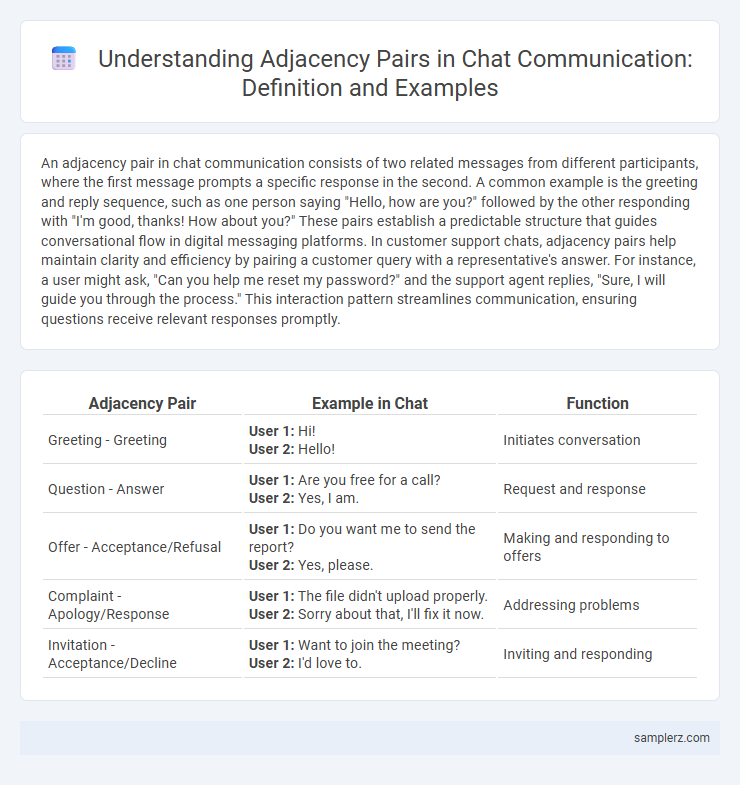An adjacency pair in chat communication consists of two related messages from different participants, where the first message prompts a specific response in the second. A common example is the greeting and reply sequence, such as one person saying "Hello, how are you?" followed by the other responding with "I'm good, thanks! How about you?" These pairs establish a predictable structure that guides conversational flow in digital messaging platforms. In customer support chats, adjacency pairs help maintain clarity and efficiency by pairing a customer query with a representative's answer. For instance, a user might ask, "Can you help me reset my password?" and the support agent replies, "Sure, I will guide you through the process." This interaction pattern streamlines communication, ensuring questions receive relevant responses promptly.
Table of Comparison
| Adjacency Pair | Example in Chat | Function |
|---|---|---|
| Greeting - Greeting | User 1: Hi! User 2: Hello! |
Initiates conversation |
| Question - Answer | User 1: Are you free for a call? User 2: Yes, I am. |
Request and response |
| Offer - Acceptance/Refusal | User 1: Do you want me to send the report? User 2: Yes, please. |
Making and responding to offers |
| Complaint - Apology/Response | User 1: The file didn't upload properly. User 2: Sorry about that, I'll fix it now. |
Addressing problems |
| Invitation - Acceptance/Decline | User 1: Want to join the meeting? User 2: I'd love to. |
Inviting and responding |
Introduction to Adjacency Pairs in Digital Communication
In digital communication, adjacency pairs are fundamental conversational structures where one participant's message prompts a predictable response, such as a greeting followed by a return greeting. For example, in a chat interaction, a message like "Hi, how are you?" typically receives a reply like "I'm good, thanks! How about you?" This exchange illustrates the adjacency pair's role in organizing turn-taking and maintaining conversational coherence in online dialogues.
Understanding Adjacency Pairs in Online Chats
Adjacency pairs in online chats commonly include question-answer sequences, such as "Are you coming to the meeting?" followed by "Yes, I'll be there." These pairs help establish clear communication by linking prompts with relevant responses, facilitating mutual understanding in digital conversations. Recognizing patterns like greeting-greeting or request-acceptance ensures smoother interactions and reduces miscommunication in virtual communication platforms.
Greeting and Reply Examples in Chat Conversations
In chat conversations, a common example of an adjacency pair is the greeting and reply, such as "Hi, how are you?" followed by "I'm good, thanks! How about you?" This exchange establishes social connection and sets a friendly tone for the interaction. Effective greetings and replies enhance clarity and engagement in digital communication.
Common Question–Answer Chat Adjacency Pairs
In chat communication, common question-answer adjacency pairs include greetings followed by responses, such as "How are you?" and "I'm fine, thanks." Another typical example involves request and acceptance pairs like "Can you send the report?" paired with "Sure, I'll send it now." These pairs facilitate smooth and coherent interactions, ensuring clarity and engagement in digital conversations.
Request–Acceptance/Refusal Patterns in Messaging
Request-Acceptance/Refusal patterns in messaging often appear in chat conversations where one participant makes a specific request, such as "Could you send the report by noon?" and the other responds with an acceptance like "Sure, I'll send it before noon" or a refusal like "I'm sorry, I won't be able to finish it today." These adjacency pairs are fundamental in digital communication for clarifying intentions and managing expectations efficiently. Effective use of request and response pairs enhances clarity and streamlines collaborative workflows in professional messaging platforms.
Complaint–Response Adjacency Pairs in Chats
In chat communication, a common example of a Complaint-Response adjacency pair occurs when a user expresses dissatisfaction, such as "My order hasn't arrived yet," prompting a customer service agent to reply with a solution-oriented response like "I'm sorry for the delay; I'll check the status and update you shortly." This interaction demonstrates key elements of complaint handling, including acknowledgment of the issue, expression of empathy, and provision of a resolution pathway. Effective Complaint-Response pairs enhance user satisfaction by addressing concerns promptly and clearly in digital communication platforms.
Invitation and Acceptance/Rejection Chat Samples
In chat communication, an example of an adjacency pair involving invitation and acceptance is illustrated when one participant asks, "Would you like to join the meeting at 3 PM?" and the other responds with "Yes, I'll be there." Conversely, an invitation followed by rejection might look like, "Do you want to grab lunch together?" met with "Sorry, I have a prior commitment." These adjacency pairs exemplify immediate and contextually relevant exchanges that structure online conversational flow.
Apology and Acknowledgement Pairing in Messaging
In chat communication, an example of an adjacency pair featuring apology and acknowledgment is when one user sends a message such as "Sorry for the late reply," followed promptly by the recipient's response "No worries, I understand." This sequence reinforces social harmony by validating the apology and maintaining conversational flow. Effective use of such adjacency pairs enhances clarity and empathy in digital messaging interactions.
Offer and Response Adjacency Pairs in Online Chats
Offer and response adjacency pairs in online chats frequently involve one participant proposing an action, such as "Would you like to join the meeting?" followed by the recipient's acceptance or refusal, like "Yes, I'll join" or "Sorry, I can't today." These pairs are essential for maintaining conversational coherence and facilitating clear communication in digital environments. Effective use of offer and response pairs enhances user engagement and ensures smooth interaction flow in messaging platforms.
The Role of Adjacency Pairs in Enhancing Online Communication
Adjacency pairs, such as question-answer or greeting-response exchanges, play a vital role in structuring online communication by facilitating clear and coherent interactions. In chat environments, these pairs help maintain conversational flow and ensure mutual understanding between participants. Effective use of adjacency pairs minimizes misunderstandings and enhances user engagement in digital dialogues.

example of adjacency pair in chat Infographic
 samplerz.com
samplerz.com